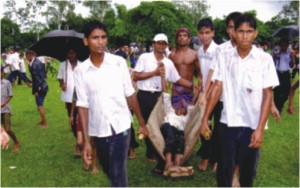Feature
Disaster risk reduction begins at school
Z.A.M.Khairuzzaman
 STUDENTS of Mirkandapara High School of Sadar upazila in Mymensingh, while attending a drill of mock cyclone at the school ground, enthralled hundreds of people by displaying their skills on disaster management. Braving a heavy shower they exhibited their skills on evacuation, search, rescue and first aid. The activities proved to be very effective in raising general awareness on safety issues related to disasters. STUDENTS of Mirkandapara High School of Sadar upazila in Mymensingh, while attending a drill of mock cyclone at the school ground, enthralled hundreds of people by displaying their skills on disaster management. Braving a heavy shower they exhibited their skills on evacuation, search, rescue and first aid. The activities proved to be very effective in raising general awareness on safety issues related to disasters.
Students attained the skills from their teachers who underwent training on disaster management. The training was imparted as part of the activities of a project titled, 'Community Based Disaster Preparedness (CBDP). Dhaka Ahsania Mission (DAM), a major development organization, launched the project in partnership with Concern Universal, another development organization, in October 2007. European Commission's Humanitarian Aid Department and Cord Aid are funding the project.
Schools are the nerve centers of a community. So, the project implementing authorities have involved students from different schools in disaster management initiatives.
Participation in dissemination activities on awareness and capacity building are their routine work. The awareness has also reached their parents.
Today an increasingly predominant view is that, for risk reduction strategies to be truly effective in protecting lives and livelihoods, they need to be people oriented.
They need to be based on people's local knowledge and cultural practices. The apply tools and approaches should be such that people can easily understand and integrate them into their lives.
On the other hand, disaster reduction using top-down interventions alone are often considered insufficient as they tend to have a lower understanding of community dynamics, perceptions and needs ignoring the potential of local knowledge and capacities.
On many occasions, local people are the main actors in disaster risk reduction and disaster response. When a disaster strikes, immediate response (i.e., search and rescue and care for those injured, traumatized and homeless) is often carried out by family members, friends and neighbours and grassroot organisations. In cases of many small-scale events triggered by natural hazards, there may be little or no external support at all. Community based disaster preparedness forms the backbone of any disaster management initiatives in societies with low government capacity.
Under CBDP project, community people learn to identify high-risk and low-risk areas as well as the most vulnerable people in their village (including the elderly, disabled and sick, lactating mothers, pregnant women, and young children). They organise themselves into groups to take care of disaster warning, rescue, evacuation, first aid, water and sanitation. Some learn how to construct rafts and life jackets, using local materials. Each family learns to prepare a survival kit (dry food for several days, candles, matches, kerosene oil) and the safe keeping of valuables and important documents.
The project is being implemented in Mymensingh, Patuakhali and Bhola. It covers 10 unions of Galachipa and Kalapara upazilas in Patuakhali, eight unions of Borhanuddin and Daulatkhan upazilas in Bhola and 10 unions of Fulpur and Mymensingh Sadar upazilas. The project will run for 15 months from October 1, 2007 to December 31, 2008. Follow-up activities are also underway in six upazilas of Jamalpur, Narsingdi and Barguna. As many as 40,000 people are direct beneficiaries and 2, 50,000 are indirect beneficiaries of the project.
 CBDP project coordinator Md Jahangir Alam said that capacity building support was provided to members of 404 Ganokendras (community learning centres) established by DAM, 432 school teachers, union disaster management committees, upazila disaster management committees, district disaster management committees and 756 UP members in all the target unions. On contact, DAM president Kazi Rafiqul Alam said knowledge resources on disaster mitigation and preparedness is extremely poor. By equipping communities with the knowledge and skills they require to prepare for an emergency rather than reacting once a disaster strikes communities are able to exercise some control over the scale of their impacts. 'Good preparation can prevent loss of lives and livelihood,' from this point of view, his organization has launched the pilot project, he said. Collaboration with local government institutions has been a prerequisite for success and long-term viability of the programme. This is why, Union Parisads have been involved with the project, he added. CBDP project coordinator Md Jahangir Alam said that capacity building support was provided to members of 404 Ganokendras (community learning centres) established by DAM, 432 school teachers, union disaster management committees, upazila disaster management committees, district disaster management committees and 756 UP members in all the target unions. On contact, DAM president Kazi Rafiqul Alam said knowledge resources on disaster mitigation and preparedness is extremely poor. By equipping communities with the knowledge and skills they require to prepare for an emergency rather than reacting once a disaster strikes communities are able to exercise some control over the scale of their impacts. 'Good preparation can prevent loss of lives and livelihood,' from this point of view, his organization has launched the pilot project, he said. Collaboration with local government institutions has been a prerequisite for success and long-term viability of the programme. This is why, Union Parisads have been involved with the project, he added.
Concern Universal official Jahangir Alam said the project could be emulated to other vulnerable areas in the country after its successful implementation. He urged the journalists to play a vital role to make people aware about possible disasters. Bangladesh frequently experiences disasters such as flood, cyclone, drought, river erosion, landslide and other hazards causing irreparable loss of life and property.
|
